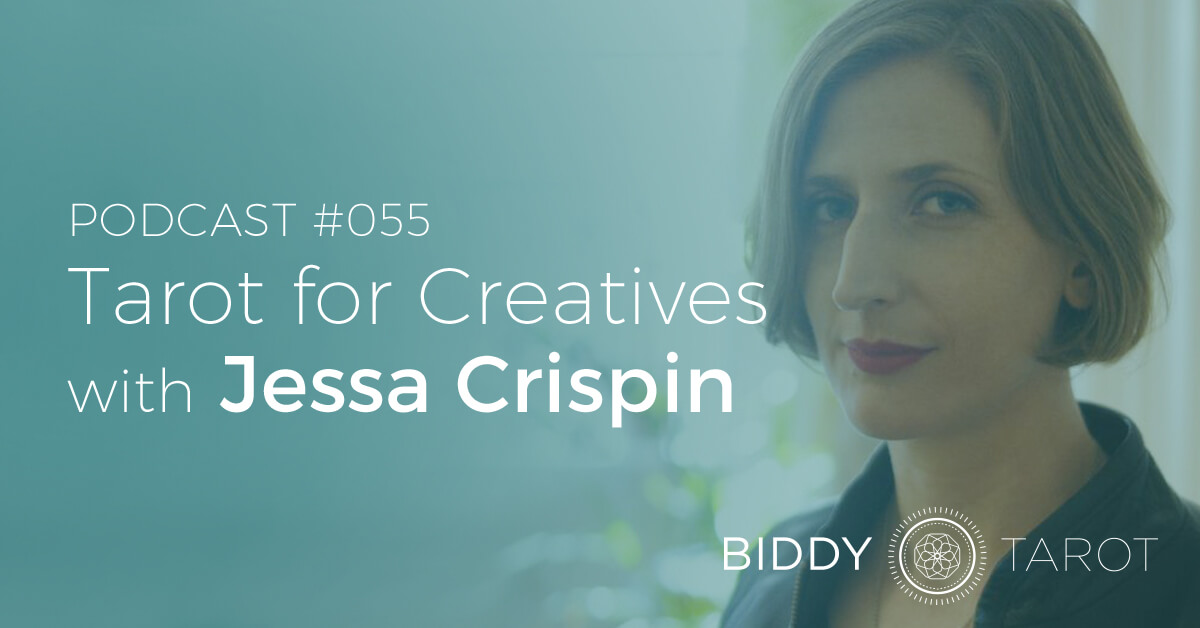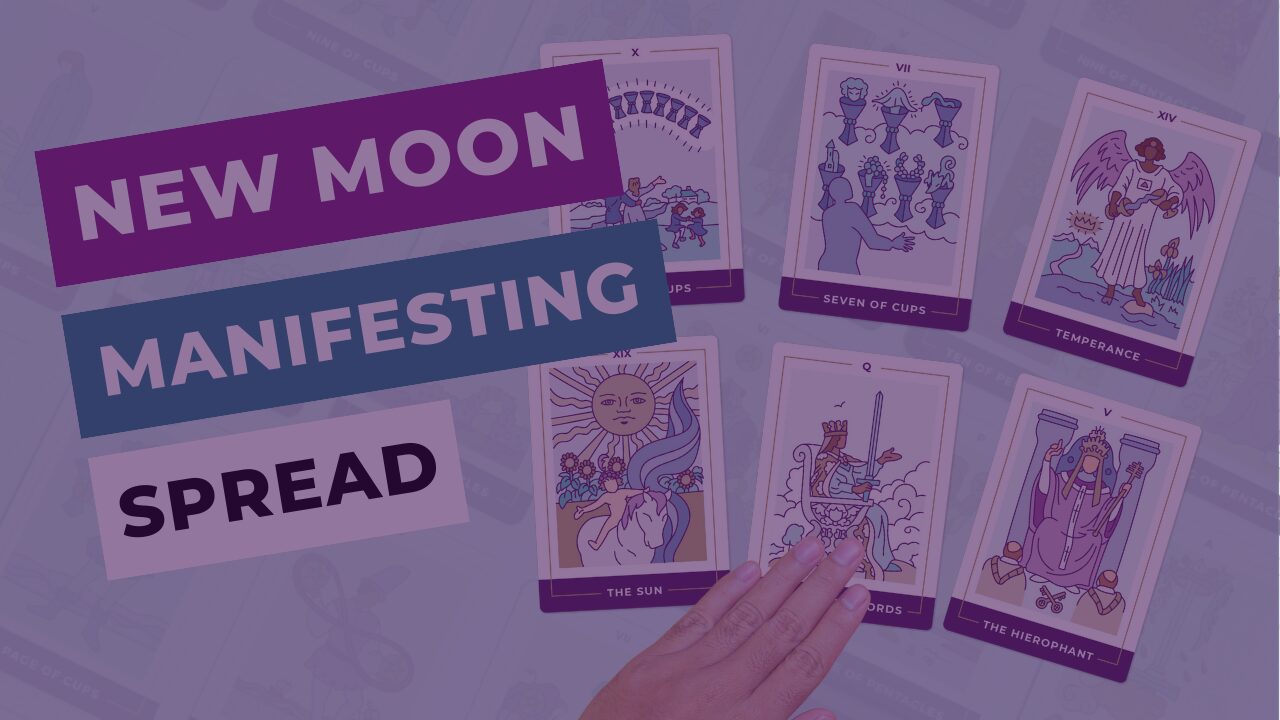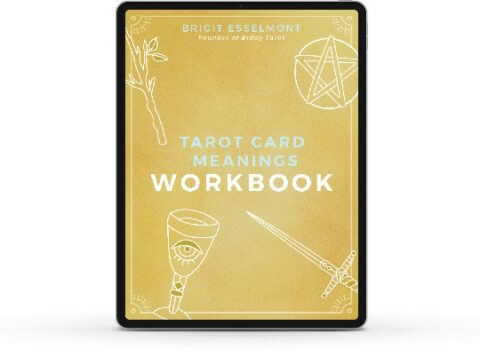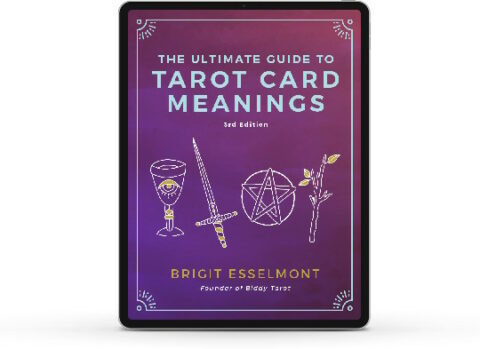
If you’re a writer or creative, this podcast episode is for you. Brigit interviews Jessa Crispin, author of The Creative Tarot, about using Tarot for creative work. In this interview, Jessa shares how she uses Tarot in writing, and how other creatives can use Tarot for inspiration.
In this episode, you’ll learn:
- How Jessa came to the Tarot as a writer
- How the cards can take on different meanings for creatives
- How to use the Tarot to provide inspiration and clarity for creative projects and storytelling
- About Jessa’s book, The Creative Tarot
Additional Resources:
- Back Jessa's new Tarot deck on Kickstarter
- Jessa’s creative essays on each of the Tarot cards
- Learn more about Jessa
- Jessa’s book The Creative Tarot
- The Castle of Crossed Destinies
- The Luminaries
- Practice reading for strangers in the Biddy Tarot Community
- Grow Your Tarot Business Online
Podcast Transcript
Brigit: You’re listening to the Biddy Tarot Podcast, and this is Episode 55: Tarot for Creatives with Jessa Crispin.
VOICE OVER
Welcome to the Biddy Tarot Podcast, where you'll learn to connect more deeply with your intuition and live an empowered and enlightened life with the Tarot cards as your guide.
Listen as Brigit and her guests share their very best tips and strategies to help you read Tarot with confidence.
And now here's your host, Brigit Esselmont.
TAROT FOR CREATIVES
Brigit: Hello and welcome back to the Biddy Tarot Podcast. As always, I am thrilled to be here in your earbuds, talking about Tarot. Today, Jessa Crispin is my special guest. She might not be the most well-known Tarot reader, but she is a well-published author and writer. She’s the founder and editor of the magazines BookSlut, and www.spoilamag.com. She’s also the author of The Dead Ladies Project, and, of course, The Creative Tarot. She’s written for many publications and has lived all across the world.
I was particularly interested in having Jessa on the podcast because of her work, with The Creative Tarot. You’re going to hear this in the interview; Jessa has found a unique and special niche in helping writers connect with the Tarot to support their creative work.
In this interview, you’ll hear Jessa talk about how she uses Tarot in her writing, plus how she’s now serving other writers in this interesting way. So without further ado, let me introduce you to Jessa!
BRIGIT: Welcome, Jessa, it is so lovely to have you here on the podcast.
JESSA: Thank you for having me!
BRIGIT: My pleasure. Jessa, you are the author of The Creative Tarot, but Tarot’s not the only thing that you do. Tell me a little bit about who you are and your purpose in the world.
JESSA: The Tarot came as a derailment for me. I got into Tarot about ten years ago. At that point, I’d already been a writer and editor of a literary magazine. So when I got into Tarot, it felt like a little embarrassing. Intellectuals are not supposed to be Tarot card readers, right? So that was a problem, and I kept it very hidden. Intellectuals are not supposed to be into the “mystical woo-woo” stuff. But I loved it, and I was passionate about it. So eventually I started doing Tarot card readings specifically for writers. I made a big announcement thinking, “My career’s going to be over, and no one will ever ask me to write anything important ever again.” But I was surprised that a ton of writers really wanted Tarot readers that knew about writing. So that’s how the creative Tarot came to be.
BRIGIT: A lot of people can relate. Many start learning Tarot and think, “Oh my goodness, what’s everyone going to think of me? This is not who I really am.” Then, after working with the Tarot for a bit, you can start to see that it actually interests many different types of people. I’m glad to hear from your perspective as a writer, and how that’s connected you even more to your writing friends.
Were you doing professional Tarot readings, or just fun Tarot readings for friends?
JESSA: For about eight years I was just studying for myself. Studying the history of the Tarot, but also each individual card, trying to get a good psychological sense of what every card meant. It really did take me eight years before I even offered to start reading for friends. Because I just felt that there is so much to know. I thought, “You’re always going to be a student. You’re never going to be an expert and people who think they are experts are maybe kidding themselves.” The eight-year process was just learning and then reading for friends. I’ve always been uncomfortable with taking money for a Tarot card reading, but I feel like it’s also important to be around someone who understands the particular problems of a creative person. And the particular problems that a writer faces during a project. Someone who doesn’t understand; who’s not a writer, just won’t be able to give the same Tarot card reading.
BRIGIT: Interesting. You’ve found quite a specific niche in terms of serving the writer population through Tarot readings. I’m curious; like you said, you felt like it doesn’t feel right to charge money. Tell me more about your thinking there.
JESSA: I don’t say that to judge people who take money for Tarot card readings. It was just very awkward for me at first to settle in on that dynamic – to declare myself as someone who actually knew what she was talking about. That was very hard for me, but I was also incredibly broke, and also it’s time consuming. I ran a literary magazine for 14 years, never made money, and I poured my soul into it. My tendency is to give too much, so this is me setting boundaries.
BRIGIT: Absolutely. I think so many people could relate with you in that initial feeling of, “Oh, am I good enough to be charging money?” or, “What if I get it wrong?” I’m sure there are many people who can relate with your journey, as well.
Just before we get into the ideas around creative Tarot, did you see any themes or patterns come up when you were doing Tarot for writers? Or do you see a broad spectrum in the Tarot?
JESSA: Writers tend to get a lot of swords because they work with their brains more. Photographers tend to get cups a lot. When they come up, you think, “Oh, there’s your intellectual energy, and this is what it’s doing,” For a writer, that is incredibly important. I find those patterns definitely exist. And also I find a lot of dark cards. Yesterday I had a client who got the Devil as the outcome, and all the other cards were bright and happy. So I find that cards like the Devil, the Tower, and cards that take on more of an archetypal quality don’t mean the same things in creative readings.
With the Devil, I was interpreting it as that person needed to go deep and dark. That resonated with her very strongly. The project she is working on was too on-the-surface and she needed that ‘oomph’ quality that the Devil could give her. I find that the cards change meaning.
BRIGIT: That’s so fascinating, I’ve never actually thought about Tarot for a specific segment of people and what might happen there, so it’s interesting to hear about your experience with writers.
I’m going to shift gears a little bit, and I’d love to explore the concept of your book with The Creative Tarot. What was the inspiration? What made you think, “I’m going to write this book and it’s going to be about the creative side of Tarot.” What was the inspiration?
JESSA: The inspiration was simply that so many of my clients were asking me to recommend a book so that they could start to learn the Tarot. I think there are some very good books on the market, but not necessarily what they were looking for. A lot of them were inspired from our creative readings to learn about the Tarot to help them with creativity when I’m not around. I can’t live with them, or follow them around saying, “Oh look, Ace of Cups, amazing!” So eventually I wanted to write it because I couldn’t find that book. I think is the best reason to do anything. If you’re looking around for something, and you discover it doesn’t exist, sometimes that means it’s your job to do that thing. That was the impetus, and the response to it has been so good, so it pleases me that it wasn’t just me and my clients that were interested in this.
BRIGIT: So when you’re looking at the Tarot card meanings from a creative angle, what’s different? How are you looking at them differently?
JESSA: Because I find that a lot of Tarot literature is understanding what’s happening to you, I feel with creative work, I wonder, “How can I use this?” It’s more active than just understanding the things that are happening to you or around you. So, it’s like, “This is the energy that’s in my life right now. How do I use it creatively or in an intellectual way to change it?” To transform it into a physical object, or a project.
I think that’s the primary difference. And I bring in years and years of veraciously reading artist writer biographies. I understand how stupid the discourse is around how an artist works, because it’s always like, “Oh the inspiration and the bravery, and then there was just a thing.” You forget that artists work. That is the thing that they do. They actually just decide to do the work everyday, and everyday is different. So you have to work with the circumstances that you’re living in. That was important to convey.
BRIGIT: It’s interesting, because I think often Tarot gets known for being a fortune-telling tool. I always find it very refreshing and empowering to be able to use the Tarot to ultimately create your destiny and discover what you really want to have happen. I guess that’s what I’m hearing here; that your intention has been, “How do we use the Tarot to create and be creative in that sense?”
JESSA: Yeah.
BRIGIT: That’s great. Are there creative ways that you use the Tarot? Particularly as a writer, do you use Tarot in your writing?
JESSA: All the time. The last project I finished was another book and I couldn’t get a handle on the structure to save my life. It felt like this big, baggy monster, and I couldn’t find the skeleton of it. I couldn’t figure out how to put it together until I realized I was dealing with Five’s energy. That blocked energy was the point of the whole book. It was everything to do with the Five cards: disappointment, frustration, that Five of Swords nastiness. Figuring that out made me think, “Oh, so all of the Five of Cups material goes in its own chapter. And all the Five of Wands material goes in that chapter.” All of a sudden, I was done. I wish I would have figured that out before I started on the project.
The FREE 5-Day
Tarot Reading Challenge
Become a More Confident,
Intuitive Tarot Reader
Join Brigit Esselmont
for an EXCLUSIVE Live Event
April 28th - May 2nd
BRIGIT: That’s interesting. Often, I think Tarot becomes a filter to help us understand different things, so perhaps that sort of came into play, as well?
JESSA: Yes.
BRIGIT: Do you write fiction or non-fiction? Or a bit of both?
JESSA: Non-fiction, exclusively.
BRIGIT: I wondered if you use it to develop characters, but clearly not. Are there other ways that writers might be able to use Tarot? Perhaps you’ve been working with your friends for how they can use Tarot in their work?
JESSA: Yeah, I’ve done Tarot readings for characters with my client. It has helped for fictional characters, when someone was feeling blocked about what was happening to the character at this point in the story. We have had conversations about a character having a certain Knight of Wands feel to her. Or a King quality, or whatever it is.
It is helpful in fiction because Tarot is a storytelling tool. Tarot card readings tell a story, so it’s enormously helpful. Italo Calvino used it to construct an entire novel, The Castle of Crossed Destinies. He really did just sit down, lay out cards, and think, “Okay, this is my book”. It has a long history of being useful for this specific purpose.
BRIGIT: I haven’t heard of that book before. We’ll make sure to get link it in the show notes because I’m sure people will be fascinated to read it. So, the author literally laid out all the cards, and that was the story, and he wrote it?
JESSA: Yes.
BRIGIT: Wow.
JESSA: I think the story is that he was an amateur and he saw somebody at a café laying out the cards and became immediately entranced overhearing the story the reader was telling the client. He thought, “Oh, I can do that.” Not in the sense of, “I’m smarter than this person,” but in the sense of, “I understand what this person is doing, and I can do that in a book.” And he did and it’s a remarkable, weird little book.
BRIGIT: I’m going to have to look that one up after we finish. Wonderful. In your book, you talk a lot about storytelling with the Tarot cards, and I think that’s where the magic is. It just extends it so much further than saying, “This card means this,” or “this card means that.” What are some of your tips for storytelling with the Tarot cards?
JESSA: I think you first have to understand the archetypes of your characters. I know writers who go all the way to writing astrological charts of their characters. The writer Eleanor Catton also did that. She wrote the astrological chart of every single character before she got started, and used that as the guide for what was possible. She did it by transit of what this person would be doing.
BRIGIT: That’s The Luminaries, right?
JESSA: Yes.
BRIGIT: I’ve read that book. That’s amazing, I didn’t know that part. I saw the astrological references in there, but I didn’t realize that a full chart was the inspiration. Very interesting.
JESSA: There’s just that sense of using it as the structure, as the skeleton, and then you can flesh it out with your own stuff. Sometimes those boundaries can be very helpful as far as saying, “Okay, this King of Cups card represents my character.” Putting it in an alignment helps you understand the motivation of who that person is, what they’re looking for in the world, and so on. I think just being playful with the deck and being open to using it as a skeleton of a project, can be really helpful and inspiring.
BRIGIT: Wonderful. I’ve used Tarot sometimes when I’m stuck on writing a blog post. I have written books, but, they’re very traditional books. I know of many other readers who use Tarot in their writings, so I think it’s an incredibly powerful tool. Do you foresee yourself writing another book on Tarot, or do you feel like you’ve done that; next project?
JESSA: We’ll see. I guess we’ll find out. I don’t foresee it at the moment, because I feel like that’s everything that I, in particular, have to say. But I do have a newsletter that shares essays about specific cards, and I find that constantly inspiring. You can find it at www.tinyletter.com/thebookslut, if anyone wants to subscribe. It finds more depth and inspiration in each individual card. Maybe there’s something there; we’ll see.
BRIGIT: I’ve found that too because I’ve got The Ultimate Guide to Tarot Card Meanings, and I wrote that between 2009 and 2011. I think back to then and now my interpretations of the cards are so different and evolved in some way. I wish the book was a living thing where I could keep adding to it. Maybe you experience the same thing?
What other projects are on the horizon for you right now?
JESSA: I just finished this big thing so now I don’t know. I just finished a book that’s going to be out in February. It’s Feminist Manifesto, and it’s incredibly different from what I have been doing, and then after that I’m not sure. We’ll see what happens.
BRIGIT: Yeah, it’s a bit of an open book, excuse the pun.
Will you continue to do Tarot readings for your writer friends? Is that how you’re using Tarot in your life?
JESSA: I still draw one card every morning, and I also have clients. If anybody’s interested in a Tarot card reading, you can find me at www.jessacrispin.com. But, yes, I still do readings for writers and all sorts of creative people.
BRIGIT: Fabulous, we’ll make sure those links are in the show notes, and I’ll also include a link to the newsletter.
I’m not even going to ask you why you’d have “TheBookSlut”. I’m guessing it’s because you love books.
JESSA: Yes!
BRIGIT: Fabulous, Jessa. It’s been such a joy to speak with you today and learning how Tarot can be used particularly for writers and creatives. It sounds like you’re working magic in that group, so I wish you all the best with that, and thanks again for being part of the podcast!
I hope you enjoyed this interview with Jessa Crispin, author of The Creative Tarot. If so, make sure you leave a review on iTunes and head over to our blog at biddytarot.com/55 and leave a comment there. You’ll also get access to the show notes and the PDF transcript for this special podcast interview.
I am so grateful for you and I’m thrilled to be talking to you about Tarot, I can’t wait to speak with you again in next week’s episode. Until then, have a great week. Thank you and goodbye!




 Harness the wisdom of the Major Arcana with 22 guided meditations. Here’s what you’ll get:
Harness the wisdom of the Major Arcana with 22 guided meditations. Here’s what you’ll get: Create a deeply intuitive and personal connection to the Tarot cards with your very own Tarot Card Meanings Workbook. Here’s what you’ll find inside the workbook:
Create a deeply intuitive and personal connection to the Tarot cards with your very own Tarot Card Meanings Workbook. Here’s what you’ll find inside the workbook: Here’s what you’ll find inside for every card in the deck:
Here’s what you’ll find inside for every card in the deck: Start doing deep, accurate readings TODAY with this step-by-step accelerated program for beginners.
Start doing deep, accurate readings TODAY with this step-by-step accelerated program for beginners.